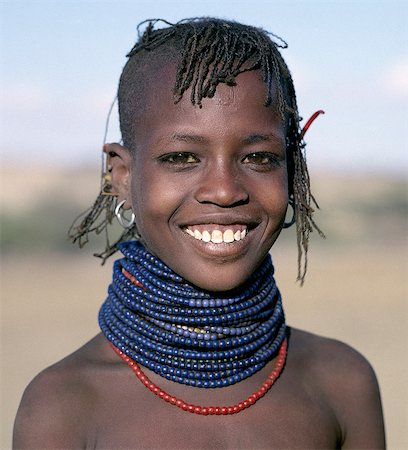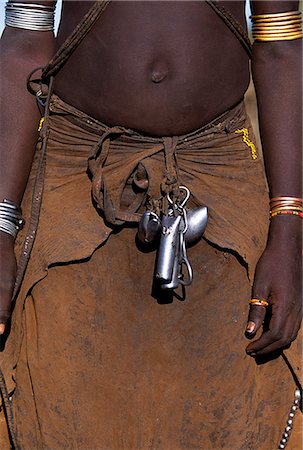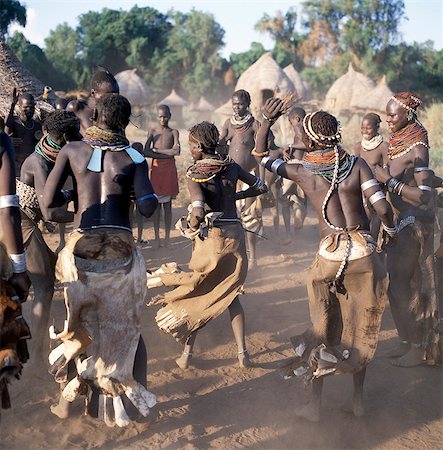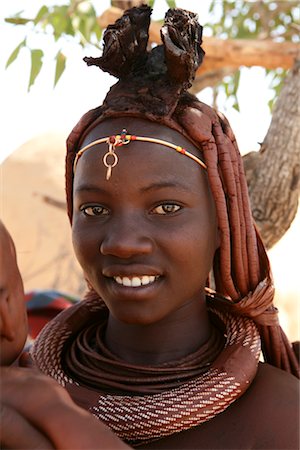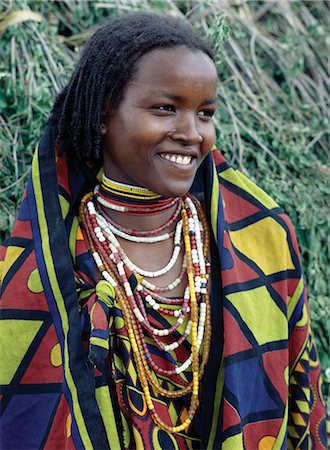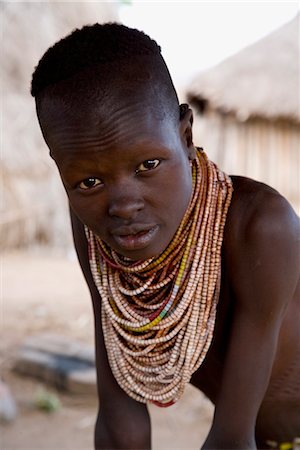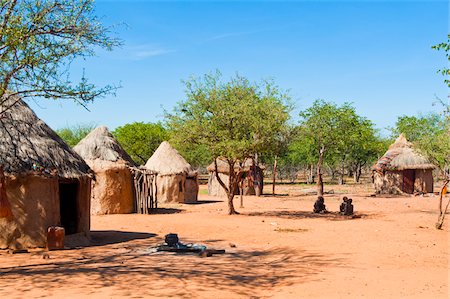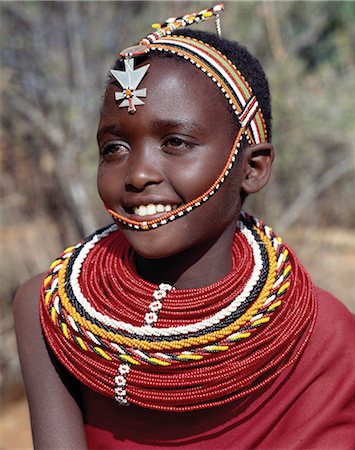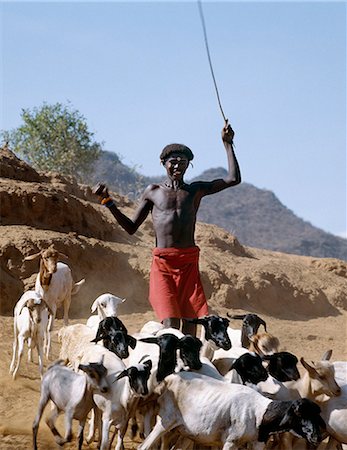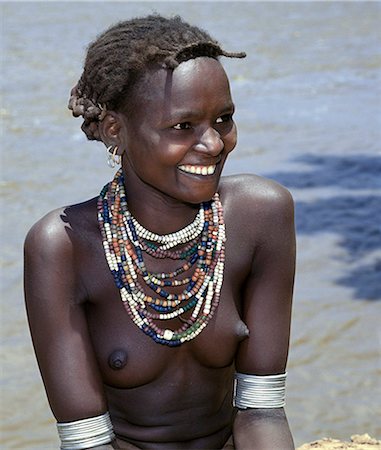-
Portrait of Himba woman, showing hairstyle of Himba women, Kaokoveld, Namibia, Africa
Con derechos protegidos
-
Maasai girls gather to celebrate a wedding. Their broad beaded necklaces with predominantly white glass beads mark then as Kisongo Maasai,the largest clan group of the tribe which lives either side of the Kenya-Tanzania border.
Con derechos protegidos
-
Two Turkana girls set off to fetch water from a nearby Waterhole. Their water containers are made of wood by the women of the tribe. Their 'V' shaped aprons are made of goatskin and have been edged with hundreds and hundreds of round discs fashioned out of ostrich eggshells.
Con derechos protegidos
-
Himba woman making butter in a dried pumpkin, Kaokoveld, Namibia, Africa
Con derechos protegidos
-
An attractive girl from the Kediyo tribe carries a large,beautifully made umbrella. Its wooden frame is covered with the dried leaves of ensete,the false banana plant (seen growing in the background). Widely cultivated in southern Ethiopia,ensete roots and stems,which are rich in carbohydrates,are either cooked and eaten as a porridge or made into bread.
Con derechos protegidos
-
A young Dassanech girl wears a leather skirt,metal bracelets and amulets and layers of bead necklaces. A long leather strap decorated with cowrie shells hangs down her back. Much the largest of the tribes in the Omo Valley numbering around 50,000,the Dassanech (also known as the Galeb,Changila or Merille) are Nilotic pastoralists and agriculturalists.
Con derechos protegidos
-
A pretty young Turkana girl has already had the flesh below her lower lip pierced in readiness for a brass ornament after her marriage. The rims of her ears have also been pierced and the holes kept open with small wooden sticks.
Con derechos protegidos
-
Turkana women and girls are responsible for watering livestock,which is unusual among pastoral societies. Here,a young girl waters goats from a waterhole dug in the sand of a seasonal watercourse. Her young brother will control the flow of stock to the water trough. In the background,a man digs out another waterhole; they have to been deepened regularly towards the end of the dry season.
Con derechos protegidos
-
A Turkana woman wears all the finery of her tribe: brass lip plug,beaded collar decorated with bleached shells of the African land snail,leaf-like ear ornaments and metal earrings from which hang tiny rings of goat horn.
Con derechos protegidos
-
A young Turkana girl adorned with necklaces of a style the Southern Turkana prefer to wear.
Con derechos protegidos
-
In the semi-arid terrain of Turkanaland,women have to travel great distances to collect firewood. Like other Nilotic people,Turkana women balance heavy loads on their heads with graceful carriage and poise. The attire of this woman is typical of married women in the tribe.
Con derechos protegidos
-
Close-up portrait of Himba children, Kaokoveld, Namibia, Africa
Con derechos protegidos
-
Himba woman milking a cow, Kaokoveld, Namibia, Africa , Namibia, Africa
Con derechos protegidos
-
Young Samburu girls dance during a wedding celebration. By arching their backs and thrusting out their chests,they flick their beaded necklaces up and down while dancing silently to the songs of the warriors. Their bodies and necklaces have been smeared with red ochre.
Con derechos protegidos
-
Young Saura tribeswoman winnowing village crop of newly harvested rice by hand, Orissa, India, Asia
Con derechos protegidos
-
A Maasai girl in traditional attire. The predominant white colour of her beadwork and the circular scar on her cheek denote that she is from the Kisongo section of the Maasai,the largest clan group,which lives either side of the border in Kenya and Tanzania.
Con derechos protegidos
-
A young Dassanech girl wears a beautiful array of beaded necklaces. Much the largest of the tribes in the Omo Valley numbering around 50,000,the Dassanech (also known as the Galeb,Changila or Merille) are Nilotic pastoralists and agriculturalists.
Con derechos protegidos
-
A young Dassanech girl wears a leather skirt,metal bracelets and amulets and layers of bead necklaces. Much the largest of the tribes in the Omo Valley numbering around 50,000,the Dassanech (also known as the Galeb,Changila or Merille) are Nilotic pastoralists and agriculturalists.
Con derechos protegidos
-
A Turkana girl's necklaces are well-oiled with animal fat and glisten in the sun. Occasionally,a girl will put on so many necklaces that her vertebrae stretch and her neck muscles gradually weaken. The partially shaven head is typical of Turkana women and girls.
Con derechos protegidos
-
An Afar girl has tribal scarification on her cheeks. Scarification is practiced in only a few sections of her tribe. Proud and fiercely independent,the nomadic Afar people live in the low-lying deserts of Eastern Ethiopia.
Con derechos protegidos
-
A Turkana girl in all her finery. Among the Turkana,cicatrization is a common form of beautification. She wears a crucifix given to her by a missionary; they are popular ornaments despite not necessarily being associated with Christianity.
Con derechos protegidos
-
Two Giriama girls pound corn outside their home using a large wooden mortar and pestles. Their small skirts are made from strips of printed cotton material - a traditional dress of Giriama women and children.
Con derechos protegidos
-
A lively Nyangatom dance is enjoyed by villagers in the late afternoon.The elevated houses in the background are both homes and granaries, which have been built to withstand flooding when the Omo River bursts its banks The Nyangatom are one of the largest tribes and arguably the most warlike people living along the Omo River in Southwest Ethiopia.
Con derechos protegidos
-
Colourfully dressed and face painted local ladies celebrating the traditional Sing Sing in the Highlands, Papua New Guinea, Pacific
Con derechos protegidos
-
Turkana girls return home from a Waterhole with water containers made of wood. Their cloaks are goatskin embellished with glass beads.
Con derechos protegidos
-
Red Ochre (or ocher stone) pigment used by Himba to create a reddish tint, Kaokoveld, Namibia, Africa
Con derechos protegidos
-
Turkana women and girls are responsible for watering livestock,which is unusual among pastoral societies. Here,a girl waters cattle from a Waterhole dug in the sand of a seasonal watercourse. The Turkana manipulate the horns of their ox's into perfect symmetry or any whimsical shape that takes the owner's fancy.
Con derechos protegidos
-
Samburu girls paint each others faces with abstract designs in readiness for a dance. Already,their necks and beaded necklaces have been coated with red ochre. Only girls and warriors decorate their faces; the orange powder they use is called blue.
Con derechos protegidos
-
A pretty Borana girl at Mega in southern Ethiopia wears brightly coloured cotton cloth and numerous strings of beads. The pastoral Borana live either side of the southern Ethiopian/northern Kenya border and form a large and important group of the Oromo-speaking cluster of tribes.
Con derechos protegidos
-
A young Datoga man tends his family's livestock on the plains east of Lake Manyara in Northern Tanzania.The Datoga (known to their Maasai neighbours as the Mang'ati and to the Iraqw as Babaraig) live in northern Tanzania and are primarily pastoralists..
Con derechos protegidos
-
A Giriama girl from Kenya's Coast Province carrying a gourd full of water on her head. Her small skirt is made from strips of printed cotton material.
Con derechos protegidos
-
Samburu girls are given strings of beads by their fathers when they are still young. As soon as they are old enough to have lovers from the warrior age set, they regularly receive gifts from them.Over a period of years, their necklaces can smother them up to their necks.
Con derechos protegidos
-
Portrait of a Karo tribeswoman, Lower Omo Valley, Ethiopia, Africa
Con derechos protegidos
-
A young Karo girl in the doorway of her hut in the village of Duss. A small Omotic tribe related to the Hamar,who live along the banks of the Omo River in southwestern Ethiopia,the Karo are renowned for their elaborate body painting using white chalk,crushed rock and other natural pigments.
Con derechos protegidos
-
A Samburu woman resplendent in her beaded necklaces and numerous bracelets makes best use of a large rainwater pond to wash herself. Water is scarce in much of Samburuland.
Con derechos protegidos
-
A young mother and child of the Arsi-Oromo people west of Aje. Both have unusual hairstyles. The braids falling from the crown of the mother's head have been attractively woven with wool to make a colourful fringe.
Con derechos protegidos
-
A Turkana woman,typically wearing many layers of bead necklaces and a series of hooped earrings with an pair of leaf-shaped earrrings at the front,sits in the entrance to her hut.
Con derechos protegidos
-
A Datoga woman relaxes outside her thatched house.The traditional attire of Datoga women includes beautifully tanned and decorated leather dresses and coiled brass armulets and necklaces. Extensive scarification of the face with raised circular patterns is not uncommon among women and girls.
Con derechos protegidos
-
A Dassanech woman winnows grain by pouring it from her metal tin and letting it fall onto a calfskin. Much the largest of the tribes in the Omo Valley numbering around 50,000,the Dassanech (also known as the Galeb,Changila or Merille) and Nilotic pastoralists and agriculturalists.
Con derechos protegidos
-
When a Turkana woman gives birth,four goats will be slaughtered in a twenty-four-hour period to celebrate the occasion. The skin of the first goat will be made into a pouch for carrying the baby on its mother's back. The small wooden balls on the back of this pouch are charms to ward off evil spirits. The baby is wearing a bracelet of ostrich eggshell beads.
Con derechos protegidos
-
A young Turkana girl wearing an attractively beaded leather apron and belt stands outside her mother's home. Sansevieria or wild sisal lines the lower walls of the house. Cicatrization round the nipples of a girl is not an uncommon form of beautification.
Con derechos protegidos
-
Traditional lifestyle of families on courtyards outside of homes, with modern little bike, Tiebele, Burkina Faso
Con derechos protegidos
-
A young Samburu herdsman drives goats towards a Waterhole along the Milgis - a wide,sandy seasonal watercourse which is a lifeline for pastoralists in the low-lying semi-arid region of their district. The hair style of the young man denotes his status as an uncircumcised youth.
Con derechos protegidos
-
Close-up of woman's legs and feet, sitting on decorated round henhouse with eggs, Tiebele, Burkina Faso
Con derechos protegidos
-
Young Batak tribeswoman weaving sarong with traditional Batak Toba design, Buhit, Samosir Island, Lake Toba, Sumatra, Indonesia, Southeast Asia, Asia
Con derechos protegidos
-
A Datoga woman relaxes outside her thatched house.The traditional attire of Datoga women includes beautifully tanned and decorated leather dresses and coiled brass armulets and necklaces.The Datoga live in northern Tanzania and are primarily pastoralists.
Con derechos protegidos
-
A Turkana woman sitting in the doorway of her hut. Her heavy mporro braided necklace identifies her as a married woman. Typical of her tribe,she wears many layers of bead necklaces and a beaded headband.
Con derechos protegidos
-
Gabbra women sing and dance to celebrate a wedding. The traditional metal ornamentation on their heads is called malmal.
Con derechos protegidos
-
Shaded from the hot sun, a Karo woman grinds sorghum using large flat stones.It is customary for females of the tribe when in their teens to make a small hole in the flesh below their lower lips into which they put an ornament, this woman has used a small nail. Numerous heavy metal bracelets are worn by married womenThe Karo are a small tribe living in three main villages along the lower reaches o
Con derechos protegidos
-
Song is an art form ingrained in Turkana culture. At the end of a dance session,the participants invariably enjoy the Song of the Bulls. Each young man will take centre-stage to extol the praises of his favourite ox. He will explain how it came into his possession,its distinguishing traits and with outstretched arms,imitate the shape of its horns.
Con derechos protegidos
-
A Karo mother and child. Heavy metal bracelets are common among older women.The Karo are a small tribe living in three main villages along the lower reaches of the Omo River in southwest Ethiopia.
Con derechos protegidos
-
In places where water is scarce,it is not unusual to see a Samburu mother or a girl from her husband's family wash a baby by squirting it with water from their mouths.
Con derechos protegidos
-
A Mursi woman wearing a large wooden lip plate. Shortly before marriage, a girls lower lip will be pierced and progressively stretched over a year or so. The size of the lip plate often determines the quantum of the bride price. They live in a remote area of southwest Ethiopia along the Omo River.
Con derechos protegidos
-
Colourfully dressed and face painted local tribes celebrating the traditional Sing Sing in the Highlands, Papua New Guinea, Pacific
Con derechos protegidos
-
Song is an art form ingrained in Turkana culture. At the end of a dance session,the participants invariably enjoy the Song of the Bulls. Each young man will take centre-stage to extol the praises of his favourite ox. He will explain how it came into his possession,its distinguishing traits and with outstretched arms,imitate the shape of its horns.
Con derechos protegidos
-
A Samburu woman milks a camel at her homestead in the early morning. The proximity of the calf helps to stimulate the flow of milk. Baby camels have a wool-like texture to their coats,which they lose after six month.
Con derechos protegidos
-
A Karo women stands in the doorway to her hut in the village of Duss. A small Omotic tribe related to the Hamar, who live along the banks of the Omo River in southwestern Ethiopia, the Karo are renowned for their elaborate body painting using white chalk, crushed rock and other natural pigments. In addition to painting her face she has decorated her body with whorls of goat hair tied by leather co
Con derechos protegidos
-
A young Daasanech girl beside the Omo River. Her hairstyle, necklaces and metal armbands are typical of her tribe.The Dassanech people live in the Omo Delta of southwest Ethiopia, one of the largest inland deltas in the world.
Con derechos protegidos
-
Bonda tribeswomen wearing traditional beaded caps and metal necklaces, selling village-made alcohol at weekly market, Rayagader, Orissa, India, Asia
Con derechos protegidos
-
A Turkana girl's necklaces are well-oiled with animal fat and glisten in the sun. The use of red ochre has been copied from their Samburu neighbours and is not widespread. Occasionally,a girl will put on so many necklaces that her vertebrae stretch and her neck muscles gradually weaken. The partially shaven head is typical of Turkana women and girls.
Con derechos protegidos
-
Bonda tribeswomen wearing traditional beaded caps and metal necklaces, selling beads to tourists at weekly market, Rayagader, Orissa, India, Asia
Con derechos protegidos
-
Bonda tribeswomen wearing traditional beaded caps and metal necklaces, with baskets on their heads at weekly market, Rayagader, Orissa, India, Asia
Con derechos protegidos
-
Colourfully dressed and face painted child of a local tribe celebrating the traditional Sing Sing in the Highlands, Papua New Guinea, Pacific
Con derechos protegidos
-
In the early morning,a young Samburu girl takes a kid to its mother. She will then milk the nanny goat leaving half the milk for the kid. Only women and children milk goats although every member of the family will drink the milk.
Con derechos protegidos
-
Colourfully dressed and face painted local tribes celebrating the traditional Sing Sing in the Highlands, Papua New Guinea, Pacific
Con derechos protegidos
-
Close-up of feet and legs of Himba woman, Kaokoveld, Namibia, Africa
Con derechos protegidos
-
A Turkana woman makes the final ties to the dome-shaped framework of her home. In wet weather,hides will be laid on top and secured with leather thongs.
Con derechos protegidos
-
Samburu girls are given strings of beads by their fathers when they are still young. As soon as they are old enough to have lovers from the warrior age-set,they regularly receive gifts from them. Over a period of years,their necklaces can smother them up to their necks. The metal cross-like ornament hanging from the girl's headband has no religious significance.
Con derechos protegidos
-
An elder of the Karo tribe sits with his wife and child. A small Omotic tribe related to the Hamar,who live along the banks of the Omo River in southwestern Ethiopia,the Karo are renowned for their elaborate body painting using white chalk,crushed rock and other natural pigments. This man also has a clay hairdo typical of tribal elders. Like most adult males he carries a rifle.
Con derechos protegidos
-
A Turkana woman sitting in the doorway of her hut. Her heavy mporro braided necklace identifies her as a married woman. Typical of her tribe,she wears many layers of bead necklaces and a beaded headband.
Con derechos protegidos
-
A Maasai woman wearing a very fine beaded necklace. The predominant white colour of her glass beadwork marks her as a Kisingo Maasai,the largest clan group of her tribe living either side of the Kenya-Tanzania border.
Con derechos protegidos
-
A Karo woman wears an elaborate headdress made from the wing-cases of beetles and a cape of calf skin fringed with cowrie shells. A small Omotic tribe related to the Hamar,who live along the banks of the Omo River in southwestern Ethiopia,the Karo are renowned for their elaborate body painting using white chalk,crushed rock and other natural pigments.
Con derechos protegidos
-
A young Samburu girl dances during a wedding celebration. By arching her back and thrusting out her chest,she flicks her beaded necklaces up and down while dancing silently to the songs of the warriors. Her body and necklace have been smeared with red ochre,and her eyebrows blackened with charcoal dust mixed with animal fat.
Con derechos protegidos
-
Samburu mothers will often carry their babies in bright cotton material tied round their waists or slung on their backs with a knot over one shoulder. Sometimes,coils of brass wire will cover women's upper or lower arms; they may be wound so tightly that movement of the arm is restricted causing the biceps to gradually weaken.
Con derechos protegidos








